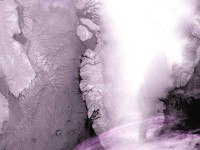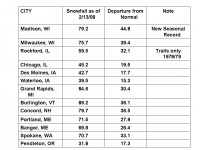Feb 17, 2008
Colorado Department of Wildlife Forced to Feed Deer in Eagle County
By Matt Terrell, Eagle County Correspondent
Feeding operations were started because the animals appear to be in desperate condition. Because of a harsh and snowy winter, wildlife managers will start feeding starving deer near Eagle and Wolcott for just the third time in almost 25 years. The consistent, heavy snowfall that’s been so good for the ski slopes has covered up the small plants and shrubs, like sage brush, that deer eat in the winter. Deer don’t store as much fat as elk, so those plants that poke up through the snow are vital to their survival.
Now, the deer are hungry enough to start stripping juniper trees, which have almost no nutrition. It’s a sure sign of desperation, says Randy Hampton, spokesman for the Division of Wildlife. The Division of Wildlife will only consider feeding animals if there’s a chance more than 30 percent of adult female deer will die in a winter. This has only happened in the winters of 1983-1984 and 1996-1997, and it looks like that could happen.

Colorado Department of Wildlife Photo
Feb 17, 2008
Enduring Tajikistan’s Coldest Winter
By Natalia Antelava, BBC, Tajikistan
After suffering its worst winter in 50 years, Tajikistan has finally appealed to the United Nations for aid. But a total loss of electricity is still a possibility, and could have terrible consequences.
In January, as temperatures dropped to a record low of -20C, people started consuming more power to keep warm and the country’s entire energy system began to shut down. In the mountains, rivers froze, leaving hydropower stations without supplies to run their turbines. And in the cities and villages, frozen pipes left millions of people without a source of drinking water. The main reservoir of the country’s biggest hydropower station is slowly but steadily running out of water. It is like a giant bathtub that has been unplugged and, once all of it goes, the whole country could shut down.
At a freezing-cold maternity ward outside Dushanbe, a nurse told me she was terrified of the disaster that a total blackout could bring. Keeping hospital patients warm is extremely difficult. Electricity supplies to her hospital are already scarce and there is no heating. Wrapped up in several blankets, newborns are kept warm with bottles of hot water that hospital staff put in their cribs. The method does not always work. Floating around Dushanbe are horrifying accounts of babies freezing to death in maternity wards, or people on life support, dying during electricity cuts. Read more here.
See the troubles in nearby Afghanistan here and here.
Feb 15, 2008
Deep Freeze in Western Greenland
The ice between Canada and southwestern Greenland has reached its highest level in 15 years. Minus 30 degrees Celsius. That’s how cold it’s been in large parts of western Greenland where the population has been bundling up in hats and scarves. At the same time, Denmark’s Meteorological Institute states that the ice between Canada and southwest Greenland right now has reached its greatest extent in 15 years.
‘Satellite pictures show that the ice expansion has extended farther south this year. In fact, it’s a bit past the Nuuk area. We have to go back 15 years to find ice expansion so far south. On the eastern coast it hasn’t been colder than normal, but there has been a good amount of snow.’

But how do these new reports fit in with continual reports that ice in the Arctic Ocean has been melting at a record rate due to increasing temperatures? And isn’t global warming at the top of the political agenda these years?
Read more here.
Feb 14, 2008
Big Climate’s Strange ‘Science’
By John Atkinson, The Register
Would you trust a software engineer to build a bridge? Climate science is a very, very new field. So new, in fact, that it has had little chance for its assertions to be tested. For example, climate models are being developed with very little ability to test out of sample. Furthermore, the climate science bandwagon has come about solely because of supposed anthropogenic climate change, which means that their funding is intrinsically tied to climate change happening and being man-made. A more self-interested group I could not find anywhere, even looking at the researchers who were paid by big tobacco companies to tell us cigarettes are safe. Of course, astrophysicists and astronomers will happily tell us about global warming on other planets in the solar system, a period of extensive solar activity and the like. But they get poo-pooed just like all the other “real scientists” who have a view. Climate scientists have to disagree with real scientists or they would lose their funding. Finally, why can’t we trust human ingenuity? At the moment, I don’t see that the evidence for anthropogenic climate change is strong enough to wreck our economies to try to change it.
The scientists who interest me in this field are those who can draw on the experience of a lot of people who have come before them. And uniformly in these areas I find scepticism. People who write mathematical models of complex systems for a living tend to find the climate models very unconvincing. Geologists find the arguments very unconvincing. Engineers find the arguments unconvincing. And astrophysicists find the arguments unconvincing. Why? Well the answers are clear: climate groupthink. Read more here.
Feb 13, 2008
The Snowy Areas This Season
By Joseph D’Aleo, CCM
La Ninas are usually snowy across the northern tier and in the north central states. This year has been an excellent example of that. Some areas have already set or are approaching new seasonal records. Some of the snowiest spots this year so far:

See larger table here
Read more on the situation in the Pacific Northwest here. This increase in snow is asociated with the flip of the Pacific Decadal Oscillation and a moderate to strong La Nina. We had written that the lack of snow in the western North America the last few decades related not to global warming as Mote had speculated but to a PDO which since 1979 has favored El Ninos and a more southerly storm track. We warned when the Pacific returned cold, the snow would return with cold temperatures from Alaska to the Northwest and across the northern tier.
While these areas have seen incredible snowfall, other areas like New York City which a few years ago had a stretch of 4 straight years over 40 inches for the first time ever, has seen motly rain or snow changing to rain. Southeastern New England which over 100 inches in places a few years ago has seen mostly bare ground.





